Category: Student News
The latest news about students and their achievements at UC Berkeley’s Haas School of Business
A chameleon chooses blue-and-gold as his colors
In person? Online? Which part-time MBA schedule is right for you?
An MFE candidate finds rewards, challenges, and community
Startup Spotlight: Download Scribble AI to write content faster than ever
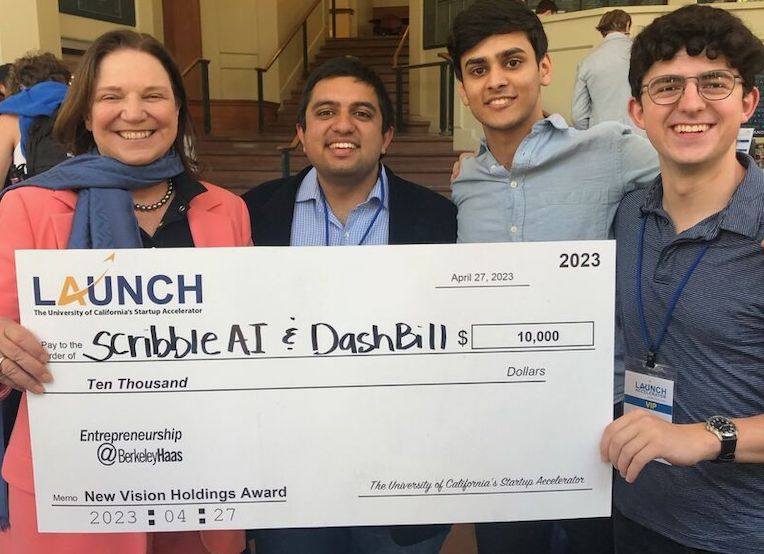
Jayaditya Sethi, BS 24 (double major in business and computer science), along with Sahil Mehta, BS 23, (Business & Electrical Engineering/Computer Science) and Ethan Jagoda, BS 24, (computer science), founded Scribble AI, an AI startup that placed third in the recent UC Berkeley LAUNCH accelerator pitch day. The startup is also part of the Batch 16 startup cohort at the UC Berkeley SkyDeck accelerator. We recently asked Sethi, who will be a software engineering intern at PayPal this summer, five questions about Scribble AI. (Download the app here.)
Tell us what ScribbleAI is and how people use it?
Scribble AI is a simple mobile interface people can download that uses AI to effortlessly create customized written content live on iOS and Android phones. It can be used to generate emails, poems, tweets and everything in between across 12 different languages and 20+ style customizations.
What is your favorite way to use ChatGPT (an artificial intelligence chatbot developed by OpenAI)?
Our favorite use for ChatGPT is for debugging code as this was crucial for us to launch the app within two weeks without any prior mobile development experience.
How did you meet your co-founders Ethan and Sahil?
We have been close friends since starting at UC Berkeley. Sahil and Ethan met through the startup accelerator and consulting club Entrepreneurs@Berkeley. Ethan and I met through a class and are now roommates. We have all collaborated on previous projects, such as being part of Entrepreneurs@Berkeley leadership and co-founding a music club together.
What is the most important takeaway from participating in LAUNCH?
Our biggest takeaway from LAUNCH was to constantly challenge our assumptions about our business. During each workshop, the mentors at LAUNCH questioned our hypotheses about our product and its use cases, helping us find a scalable business model. For example, we learned to find the root causes of a customer’s problem, rather than simply take what a user says at face value. These are lessons we will carry for years as we continue our startup journey!
What are your plans for Scribble AI now?
We plan to scale up traction in international markets, particularly among social media creators who need a tool to write content 10 times faster. We are also developing the premium version of our app, which will be tailored to each user’s specific needs
Cal tops Stanford in Golden Shovel Real Estate Competition
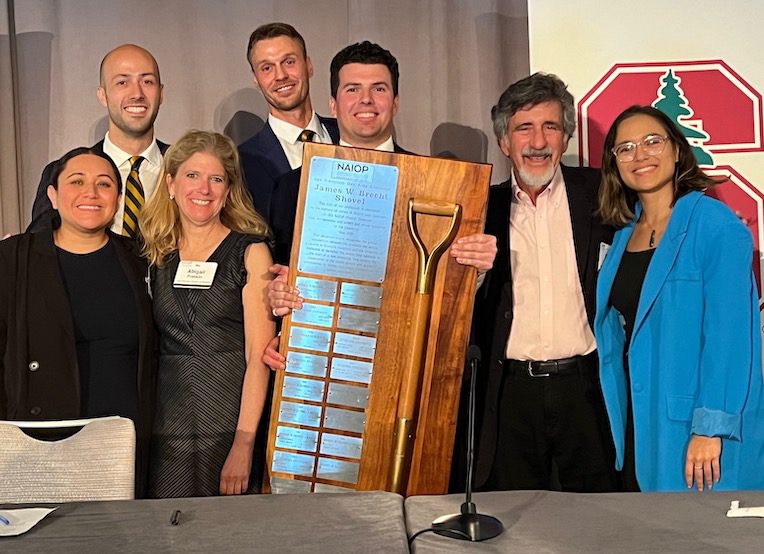
The Win: First place in the NAIOP San Francisco Bay Area (SFBA) Real Estate Challenge, held April 27. The friendly real estate development competition between UC Berkeley and Stanford celebrated its 34th year, with Cal taking home the coveted James W. Brecht Memorial Golden Shovel. The team’s $2,000 prize is donated to the nonprofit Challenge for Charity.
The Team: The Cal team included two Haas MBA students, Marshall Slipp, MBA 23, and Jack Woodruff, MBA 23; and three students in the UC Berkeley Master of Real Estate Development and Design program, including Esmeralda Jardines, MRED+D 23; Jordan Doane, MRED+D 23; and Serena Lousich, MRED+D 23.
The Challenge: Each year, organizers pick a development site that’s within driving distance of Berkeley and Stanford. Students don’t find out where the site is until the night before their first meeting. This year’s site was the San Francisco Wholesale Produce Market. “Typically the site that’s selected has challenges associated with it that make the development associated with it complicated,” says Marshall Slipp, MBA 23. “As a team, you have to work through those challenges.” The team had nine weeks to prepare a 100-page proposal explaining the vision, site design, development phases, and financials for the deal. In this case, the largest challenge was the limited equity available for the redevelopment project.
The Pitch: The UC Berkeley team pitched a plan to unlock as much equity as they could by obtaining permanent financing for some of the buildings that would remain on the site long-term. They also proposed a small capital campaign for the nonprofit owner and bringing in the expertise of a joint venture partner for redevelopment. “Bringing in a joint venture partner to help redevelop the site provides a lot of advantages in terms of raising capital, obtaining better financing terms, understanding the development process, and managing the redevelopment process,” Slipp said.
The Clincher: The UC Berkeley team proposed a multi-story industrial development that would upgrade the San Francisco Produce Market with cold storage facilities and a commercial kitchen hub for local food-based businesses. The design also featured fleet storage space for electrified autonomous vehicles, making the project financially feasible and readying the Produce Market for a new era of logistics and delivery.
The Haas Factor: The team credited Haas’ overall strength in real estate. Competition advisors Abigail Franklin and Bill Falik and the Fisher Center for Real Estate and Urban Economics faculty worked to validate and challenge the team’s assumptions. They also helped connect the team to developers, property managers, prospective tenants, and financiers. Leveraging these networks, the team conducted more than 60 interviews to hone their ideas and complete due diligence. In addition, this year’s team received coaching and moral support from last year’s winners, which helped the team stay inspired, refine the process, and benchmark progress.
Matt Solowan, MBA 23, on questioning the status quo and finding a fit at Bain consulting
Haas Voices is a first-person series that highlights the lived experiences of members of the Berkeley Haas community.

Matt Solowan, MBA 23, embodies the Berkeley Haas Defining Leadership Principle Question the Status Quo in both work and life. In this Haas Voices column, Solowan discusses their commitment to workplace inclusivity, their work as a marketer at L’Oréal, and a love of all kinds of dance. Solowan will join Bain & Company in New York after graduating this month.
“Dance has always been a passion of mine. Growing up on Long Island, I did tap, jazz, ballet, lyrical, and hip hop lessons from a very young age. In high school, I was on the kickline team and we performed at football and basketball games and competed in local and national competitions. Dance was my entire life. But when I got to USC as an undergrad, I realized that it wasn’t something I wanted to do professionally, so I took it as a minor and then picked up economics, along with Italian, as a major.
As a junior at USC, looking for a summer internship, I remember this one interview I had with a bank. At that time, I presented quite femininely. I had longer hair and wore makeup. I sat down and saw this smug guy looking over my resume. I had a 4.0 as an economics major and he spent the entire time grilling me about my dance minor, correcting me that dance was my “hobby” when I called it a “passion.” That was all he could see. He didn’t care that I had a 4.0 in economics. I could tell he’d written me off the minute that I walked into the room.
I had a 4.0 as an economics major and he spent the entire time grilling me about my dance minor, correcting me that dance was my “hobby” when I called it a “passion.”
I left that interview feeling so dejected and made a point that this was the type of person that I would prove wrong in my career. Luck would have it that within the next week or two, I went to an event that L’Oréal was hosting on my campus.
At that time, I didn’t even know that you could market beauty products as a career. But when I met with the L’Oréal recruiter it was a total 180 from what I had experienced at the bank interview. Without looking back, I accepted an internship, which turned into a career working on the marketing teams across a handful of L’Oréal-owned brands, including IT Cosmetics, Maybelline, and Garnier.
Making a mark at L’Oreal
Here, I learned that having as many diverse voices as possible on work teams is so critical as it impacts everything from the makeup shades a company markets to how the company hires for its advertising campaigns. There is a pervasive culture in large beauty organizations, where beauty is viewed through the eyes of the white male gaze—white, European features, thinner, and younger women. But you have junior talent who are ready to break away from that and the old-school view of beauty.
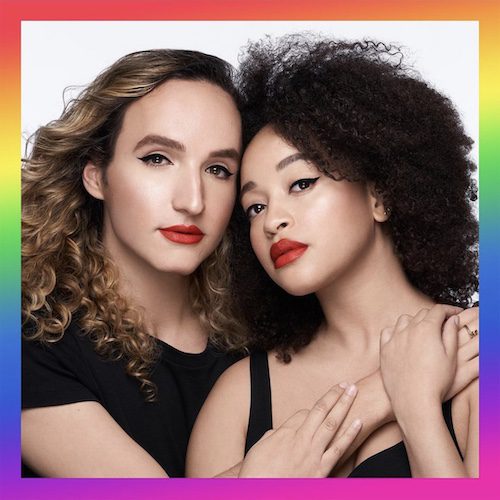
On one brand launch I worked on I was given was a rainbow-handled makeup brush for Pride Month. I immediately flagged the launch as “rainbow-washing,” —which is when businesses use rainbow colors to suggest support for the LGBTQ community without making any tangible effort to positively impact the lives of LGBTQ people. I reached out to L’Oréal’s employee resource group for LGBTQ employees, who put me in touch with a local charity and I worked with them on a plan to have some of the sales from the brush tie back to a center for LGBTQ youth.
I was devastated when my plan was rejected by a company manager due to budget cuts. But then one of our key retailers put the brush on their website earlier than anticipated and immediate backlash from consumers started flooding in. I could have had a “told you so” moment.
Instead, I reached back out to that charity, and got things back in motion and we officially launched the brush tied to this charity. Doing what’s right isn’t always easy, which I experienced first-hand modeling for some of the brand campaigns. These multimillion, sometimes billion-dollar brands, often have employees shoot videos and images to post on social media. I was featured in quite a few of their marketing materials that went up on our Instagram. As a model, I would get very nasty hate comments from some of our consumers. That was very hard for me to reckon with. I was an employee of this brand putting my face forward and some of the consumers of this brand had a negative reaction to seeing me.
Doing what’s right isn’t always easy, which I experienced first-hand modeling for some of the brand campaigns.
But looking back, it is something I’m very proud of. I helped push a brand forward. My motto has always been, if I can have one person look at that image, and see themselves represented and feel like there is a space for them, that means much more to me than a hundred negative comments from people who really do not matter to me. It’s a trade off I’m willing to make.
Why an MBA?
At L’Oréal, I met a few people I admired for the way they spoke and presented, and the way that they tackled problems. I found out that a lot of them had MBAs and had previously worked in management consulting. It was a formula that I thought might be a good path for me.
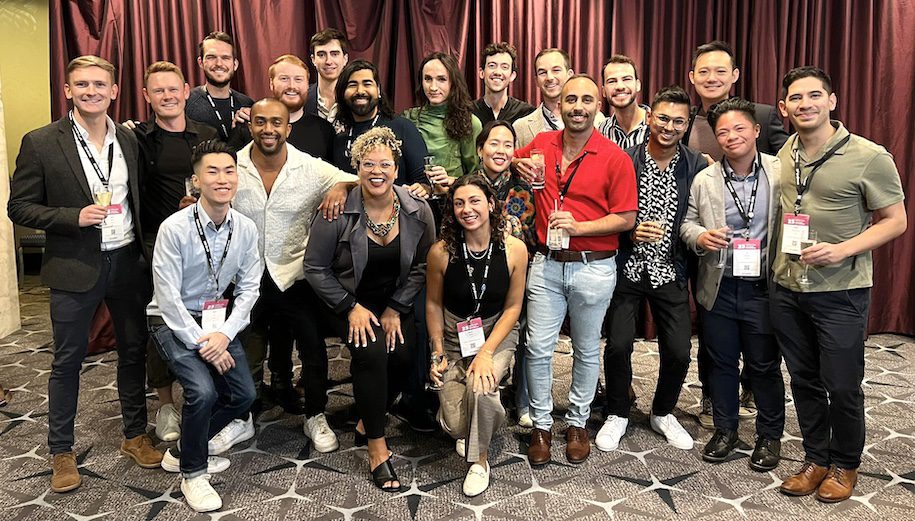
When I came into Haas I was determined to land an internship in consulting. One of the most helpful resources to me at Haas was the second year peer advisors who had just gone through the recruiting process. They were the ones who looked at my resume, reviewed my cover letters, and were practicing cases with me during the fall and into winter break. We have a very strong pay-it-forward culture at Haas. I ended up becoming a peer advisor myself, working with both the second-years in my class who were recruiting for full-time roles in consulting and the first-years recruiting for internships. I think that was one of the most rewarding things I did at Haas.
We have a very strong pay-it-forward culture at Haas.
Heading to Bain
I chose Bain over other firms I received offers from because, even though it has a generalist model and I am hoping to specialize in retail and consumer early on, I loved all of the people that I met at Bain during the recruiting process. They were in many ways similar to the people I know at Haas: very down to earth, very kind, very warm, very supportive. I knew that consulting would be a tough job. I knew the hours would be long. It’s a rigorous role to go into post MBA. I wanted to make sure that I was surrounded by a good support system and I felt like I had met people there who would be cheerleaders for me. That carried a lot of weight.”
Pitching with purpose: Students imagine future of mobility for automaker
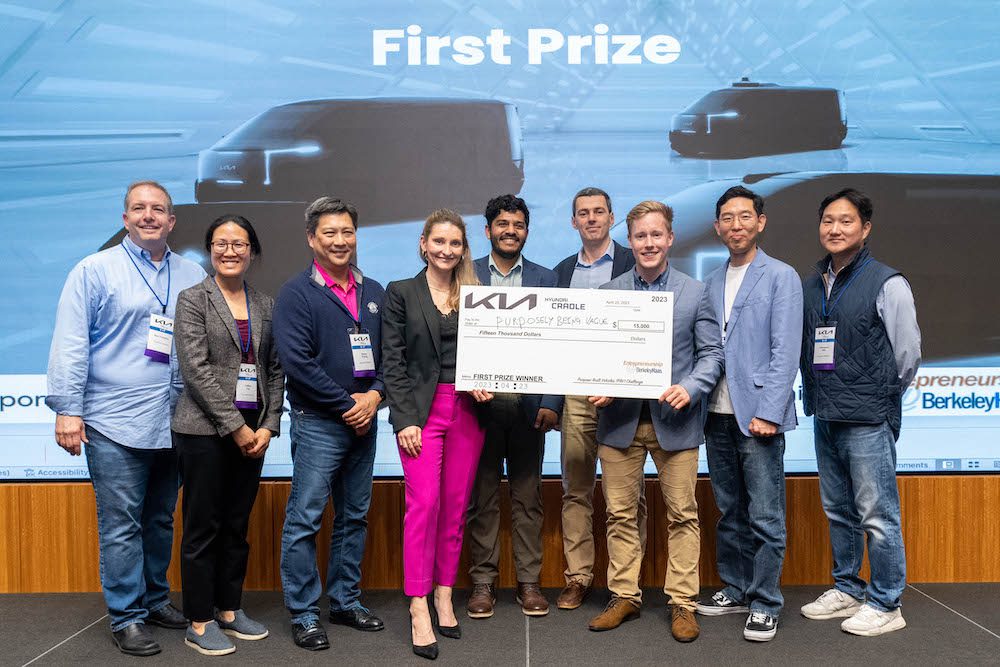
A student team that imagined a plan for Hyundai Cradle to build an electric-powered mobile medical fleet and market it in North America won the 2023 Haas Purpose-Built Vehicles (PBV) Challenge.
Hyundai Cradle, Hyundai Motor Group’s Mountain View, Calif.-based open innovation and investment arm, sponsored the challenge, which was held April 23 at Berkeley Haas.
Cradle challenged students to develop novel business models for the company’s future PBV market launch in North America. Hyundai Motor Group is in the final stages of building a flexible automobile base, called a skateboard, that can be used to produce many kinds of PVBs—vehicles ranging from ambulances to passenger shuttles to delivery fleets for small businesses.
The first-place team took home $15,000 for its pitch. Winning team members included Srivatsa Chakravarthy, EWMBA 25; Oleksandr Krotenko, EMBA 23; Victoria Marcus, EWMBA 25; and Simeon Ryan, EWMBA 25.
The competing teams, composed of graduate students from across all three Haas MBA programs and the UC Berkeley School of Information, participated in a semester-long series of training sessions, focused on the Lean Startup method and customer discovery training. The top three finalist teams were then tasked with finding and validating novel business models for PBVs that they pitched to judges at the end of the program.
“This was a fantastic way to showcase students from across all three of our MBA programs,” said Rhonda Shrader, executive director of the Berkeley Haas Entrepreneurship Program (BHEP). “The program also provided a perfect opportunity for our MBA students to work with top graduate students from across the campus.”
Solving real problems
The winning group pitched a fix for emergency medical services that they described as “antiquated, expensive, and ripe for technological disruption.” The team suggested that Cradle partner with industry leader AMR (American Medical Response) to capitalize on the company’s market share and need to contract with an outsourced fleet.
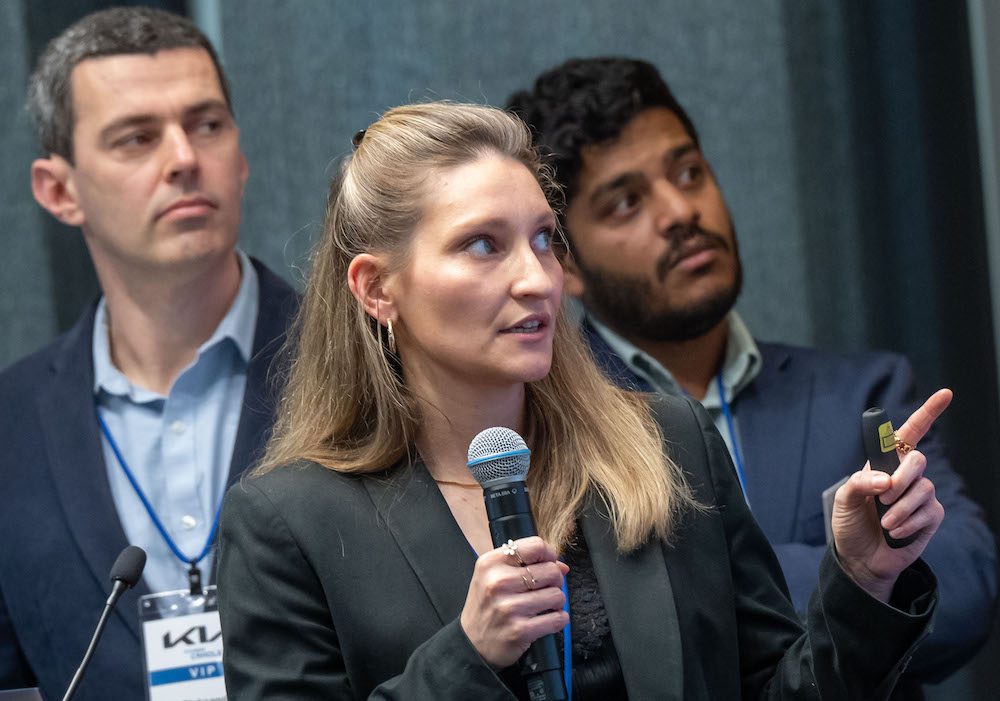
Marcus, who works in corporate finance, said she was excited to work on solving a real problem experienced by a company outside of her industry.
“Going through the pitching process with judges was the pinnacle business school experience I’ve always wanted to try since I started my EWMBA,” she said. During Lean Launch, she said her group conducted more than 30 interviews with potential clients. “We had to pivot a couple times from our original idea to make sure we were solving problems for them,” she said. “Ultimately this led us to think hard and adapt so we could develop a detailed business plan that would benefit potential clients.”
During the pitch day, Kia’s vice president of new business planning, Ju yup Kang, a judge for the competition, outlined how KIA is transforming from a car company to a “full mobility solution provider.” Henry Chung, senior vice president and head of Hyundai Cradle, said the students had clearly put in a lot of effort to develop creative solutions to difficult problems.
Chung; Kang; Changwoo Kim, a chief coordinator at Cradle; Tafflyn Toy, an open innovation project manager at Hyundai Cradle; and Nick Triantos, chief architect, automotive system software at Nvidia, served as the final challenge judges.
Team Ingenium took second place ($10,000) with a pitch for all-in-one fleet management. Members included Reggie Draper, EMBA 23; Michael LaFramboise, MBA/MEng 24; Matthew McGoffin, MBA/MEng 23; and Michael Yang, MIMS (master of information management and systems) 23.
Team Mobility Moguls took third place ($5,000) for a strategy that addressed a mobile future for police & security. Team members included Anmol Aggarwal, EWMBA 24; Suveda Dhoot, MBA 24; Hrishikesh Nagaraju, MIMS 24; Nithin Ravindra, EWMBA 23, MIMS 24; and Lutong Yang.
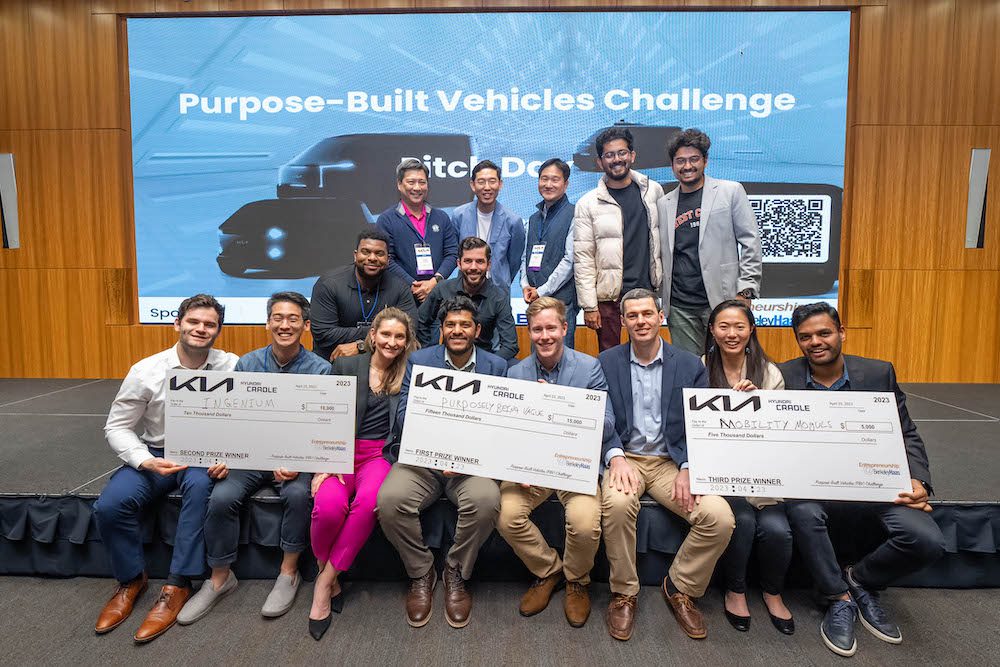
Haas MBA student team nabs $75,000 for supply chain startup at Impact Pitch Competition
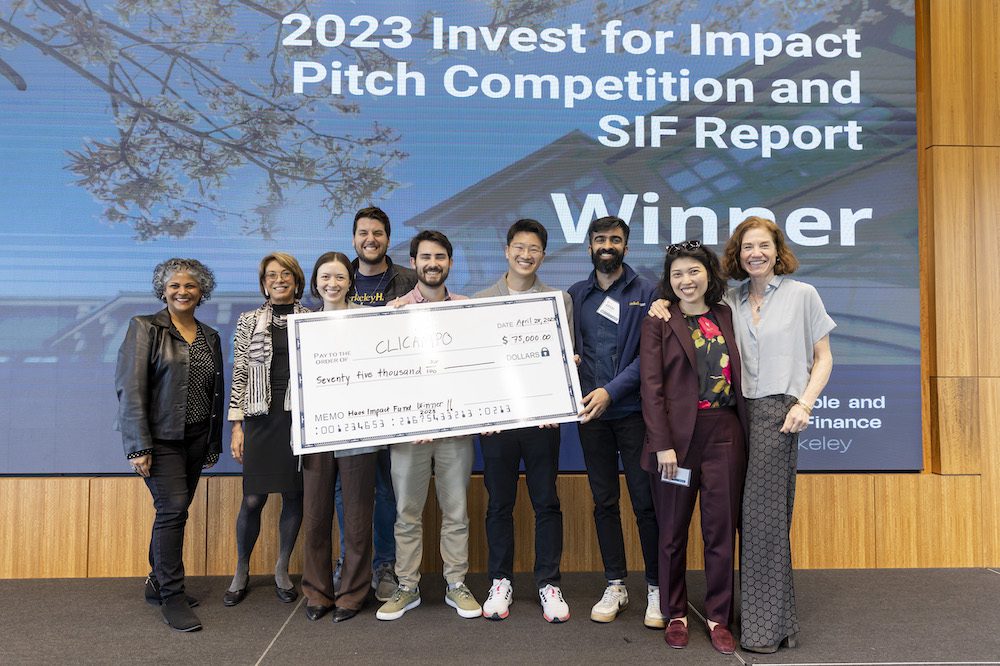
An MBA student team won first-prize funding for a startup that’s helping to make supply chains more efficient for small Brazilian farmers at last Friday’s Invest for Impact Pitch Competition.
The winning team, pitching on behalf of startup Clicampo-Arado, included Arsal Khanani, EWMBA 24, Byungwoo Han, MBA 23, Gui Klingelfus, MBA 23, Mateus Loesch, MBA 23, and Vivian Hare, EWMBA 23.
Clicampo, now rebranded as Arado, secured a $75,000 investment, awarded by a panel of industry judges, including Michelle Kiang, managing partner and co-founder at Impact Science Ventures; Matt Caspari, managing partner at Alumni Ventures, and Joshua Posamentier, managing partner at Congruent Ventures.
The students who pitched are enrolled in the Haas Impact Fund course and program, part of the Sustainable and Impact Finance Initiative at Haas, which gives MBA students hands-on impact investing experience. The fund’s MBA student partners invest in early-stage impact startups throughout the spring semester, leading sourcing and conducting due diligence.
Klingelfus said he was thrilled by the team’s first-place win. “What set our team’s pitch apart was the fact that we highlighted both Arado’s social impact and its financial success, demonstrating that they are ready to scale.”
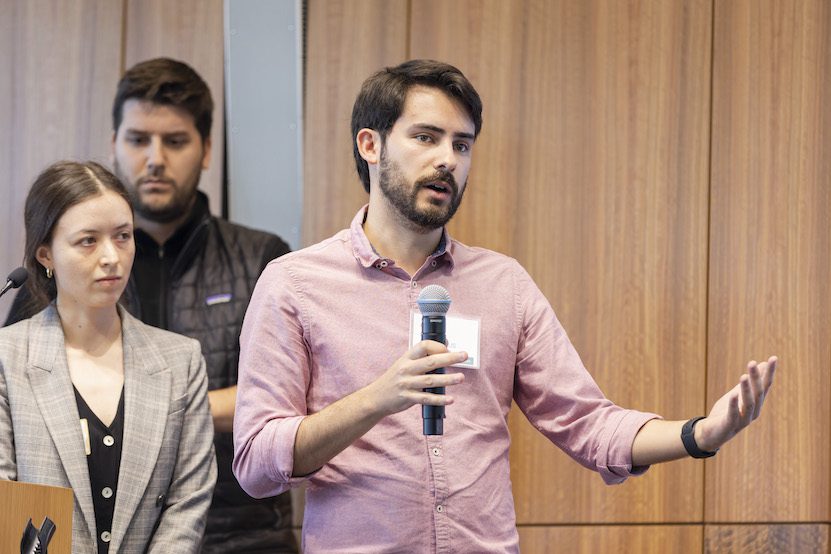
Loesch said pitching during the competition helped prepare him if he chooses to pursue a career in venture capital or entrepreneurship, as he learned about how industry pros analyze a startup’s potential.
“I don’t believe that I would have had the same experience in other classes in the MBA program,” he said.
Reducing food waste
Five MBA student teams pitched during the competition addressing some of the world’s most pressing challenges, including food waste, financial access, health, and renewable energy. The teams included Team Health & Wellbeing representing startup Shezlong; Team Sustainable Supply Chain representing startup Diferente; Team International Development representing Farm to Feed, and Team Climate Tech representing Oceans-Sway.
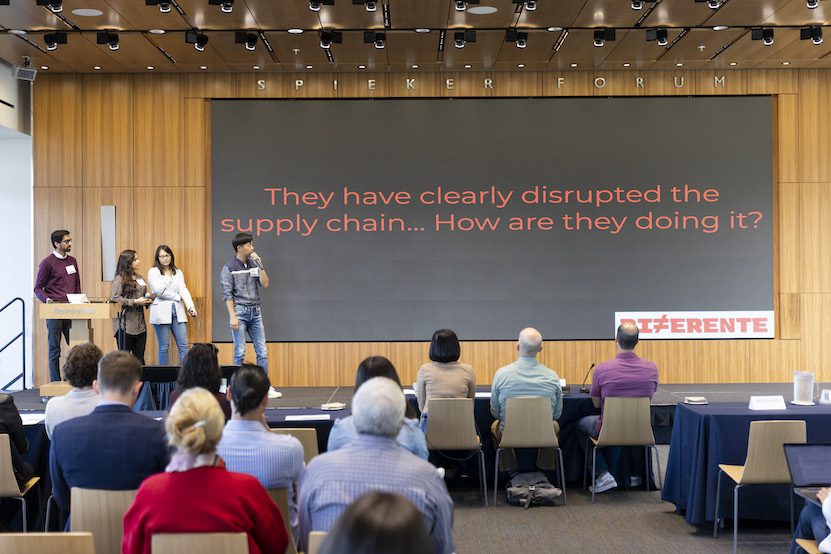
Arado’s prize comes on the heels of two other funding rounds over the past year for the startup: a $7.5 million seed round and $12 million series A funding round. Founded in 2021, Arado connects small to midsize farmers in Latin America directly with restaurants and food retailers.
“Food waste is one of the main problems in the world now, and Arado came up with an innovative solution that increases the system’s efficiency and that contributed to the success of our pitch,” Loesch said.
The day also included a report from the Sustainable Investment Fund course, the first and largest student-led SRI fund within a leading business school. It offers MBA students real-world experience in delivering both strong financial returns and positive social impact in public markets. Since 2008, the student principals have more than tripled the initial investment to over $4 million.
Freada Kapor Klein, the founder of the Level Playing Field Institute, who gave a keynote at the event, noted the importance of investing in impact startups that help close opportunity gaps for communities of color and low-income communities.
In investing, “we look at one’s lived experience,” she said. “What hurdles do they encounter along the way, and how did those hurdles give them an idea for a startup that might solve the problems?”
Entrepreneurial drive fuels a career pivot
Finding and promoting inspiration in sustainability and innovation
PayPal Ventures’ Lisha Bell, BCEMBA 12, to speak at Executive MBA commencement
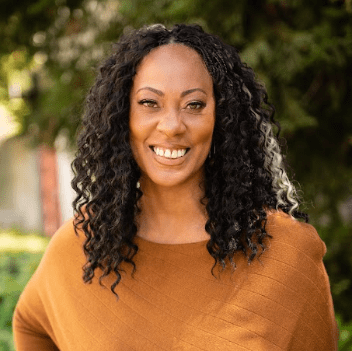 Lisha Bell, BCEMBA 12, who leads the Economic Opportunity Fund at PayPal Ventures, has been chosen as speaker at the Berkeley Haas MBA for Executives commencement, which will be held June 3.
Lisha Bell, BCEMBA 12, who leads the Economic Opportunity Fund at PayPal Ventures, has been chosen as speaker at the Berkeley Haas MBA for Executives commencement, which will be held June 3.
Bell brings over 20 years of demonstrated technology innovation focused on digital money movement. Her career has focused on building and investing in products that serve community needs to bridge the capital divide.
At PayPal Ventures, she leads the Economic Opportunity Fund, the 100M investment into diverse emerging fund managers. Prior to Paypal, she worked at Venmo, Wells Fargo, Kohl’s, and Feedzai in various payment related roles, building the earliest digital financial products including online banking, bill pay, and digital wallets.
Bell is cofounder of BLXVC, an angel syndicate comprised of moms funding Black and Brown founders.
She is also the host of the Sisters with Ventures Podcast, which tells the stories of women in venture capital, and the prior deal flow lead for Pipeline Angels, a group of impact investors focused on women. Bell is also board chair for Black Girl Ventures.
She holds a BS in Business Administration and Information Systems from USC, and an MBA from the (former) joint program between UC Berkeley and Columbia Business School. She was recognized as USC’s Widney Outstanding Alumna and a 2013 Berkeley Columbia Distinguished Service Award recipient.
Pitching for the win: MBA student interest in public markets investing rises
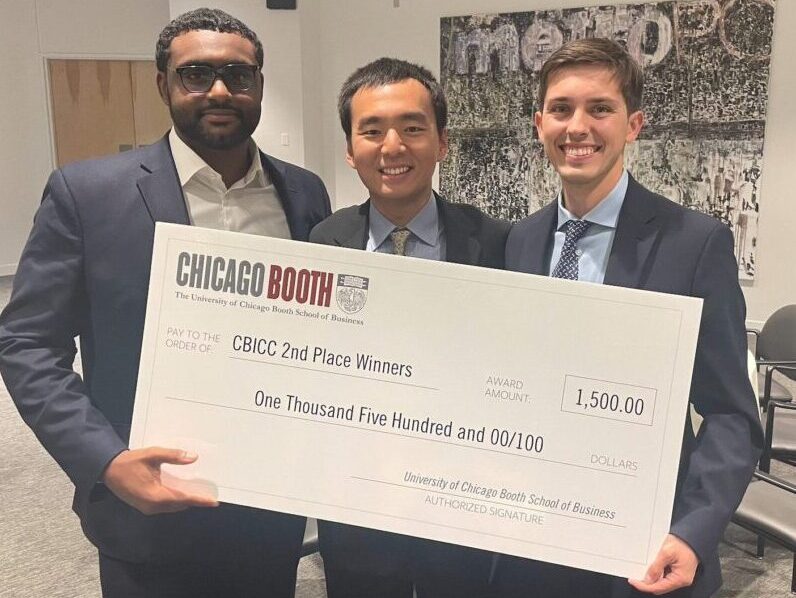
John Graft, MBA 24, admits that he went “a little overboard” competing in four stock competitions during his first year at Haas. But the hours spent paid off. His team’s stock pitch in front of judges at University of North Carolina Kenan-Flagler led to a coveted summer internship offer at his first-choice firm: Harris Associates in Chicago.
“The person who interviewed me at Harris had listened to me pitch at the UNC competition,” Graft said. For Graft and a group of Berkeley Haas students focused on careers in public markets investing, stock pitch competitions are an integral part of the Haas finance experience, allowing students to synthesize stock research and network with top firms that often judge the competitions.
Public markets investing is on the rise at Haas, said Bill Rindfuss, executive director of strategic programs for finance. Six first-year students seeking positions in public markets investing accepted summer internships at top investment firms including Blackrock, TCW, PIMCO, Clearbridge, Harris Associates, and Neuberger Berman.
“A decade ago we had up to a dozen MBA students going to public markets investing roles in a year,” he said. “Over time, student interest shifted more to tech investment banking and venture capital. While those interests remain strong, it’s great to see public markets investing bouncing back.”
Multiple internship offers
In a particularly difficult year for hiring, Haas exceeded expectations this year, with some students receiving multiple offers, said Ryan Tan, MBA 23, a Double Bear and the Berkeley Haas Investment Club president, who has worked closely with undergraduate and MBA peers to create more finance opportunities. That included bringing an impressive array of top industry speakers to Haas like Christina Ma, MBA 01, a partner and head of Greater China Equities at Goldman Sachs; Ben Meng, MFE 03, executive vice president and chairman of Asia Pacific at Franklin Templeton, and Ben Allen, MBA 05, CEO of Parnassus Investments.
In a particularly difficult year for hiring, Haas exceeded expectations this year, with some students receiving multiple offers. — Ryan Tan, MBA 23
Wearing many hats, Tan is also a graduate student instructor for the undergraduate Financial Economics course and a principal with the pioneering Haas Sustainable Investment Fund. (Since 2008, student principals in the Sustainable Investment Fund have more than tripled the initial investment to over $4 million, learning about SRI and ESG investment strategies and practices.)
Students in the public markets investing track agree that their group is collaborative, helping each other both in class and during job searches. They’re also given the chance to participate in a half-dozen stock pitch competitions that the club enters annually.
At competitions, teams develop a thesis around a stock or bond, build a financial model to value the security, evaluate the risks of the investment, and build a Powerpoint after synthesizing the research. “You put this together and pitch the security to a panel of judges, all of whom work at the top investment management firms,” Graft said.
Navigating pitch competitions
MBA students credit Tan for mentoring teams on how to navigate a pitch competition.
“He helped us to understand what the judges were looking for,” said Austin Schoff, MBA 24, a co-president of the Haas Investment Club, who led an MBA student team at the MIT Sloan School Stock Pitch Competition last November. Haas placed second at MIT Sloan, second at Chicago Booth, and third at the UNC Alpha Challenge.

Schoff, who came to Haas planning to pivot from private wealth management, landed an internship this summer with the equity research team at TCW.
“Ryan has done an enormous amount of work,” said Steve Etter, who teaches finance at Haas and is a founding partner at Greyrock Capital Group. “It’s nice to see when a student goes beyond himself for the benefit of all.”
Xavier Jefferson, MBA 24, competed in a pitch challenge online hosted by Columbia Business School and at the in-person event at Chicago Booth.
“At Haas, we go to as many challenges as we want and that gives you exposure to all the firms and prepares you to pitch a stock or bond,” he said. “That’s a huge part of the interview process, and having the practice of pitching gives you a leg up.” A Toigo Fellow and a Haas Finance Fellow, Jefferson will intern at Clearbridge this summer.
“At Haas, we go to as many challenges as we want and that gives us exposure to all the firms and prepares you to pitch a stock or bond.” —Xavier Jefferson, MBA 24
After participating in multiple pitch competitions—as usually the only woman or one of two women—on the team, Meredith Albion, MBA 24, noted that the competitions would benefit from having more female members.
As a Berkeley Haas Finance Fellow in investment management Albion was assigned a female mentor, who helped prepare her to interview for summer internships. (All 12 of the Finance Fellows named each year are assigned a Haas alumni mentor.) Albion credits her mentor with helping her land an internship at PIMCO in Newport Beach this summer. Like other first-year MBA students in the Investment Club, she plans to work on the Haas Sustainable investment Fund next year and integrate sustainable investing into her career.
With Albion, Schoff, and Graft at the helm as co-presidents of the Haas Investment Club —Tan said he’s confident that Haas will continue its success.
“The message we need to get out is that if you come to Haas for investment management and sustainable investing you will be involved and plugged in, you will be given mentorship,” Tan said. “And people get jobs.”
Ignoring limitations, taking risks, and practicing compassion
Your MBA, your way: Comparing part-time MBA options
Doctoral student relishes research and teaching
Startup Spotlight: Alokee wants to be your virtual realtor
Startup Spotlight profiles startups founded by current Berkeley Haas students or recent alumni.
Team: Matthew Parker (co-founder and CEO), Hamed Adibnatanzi (co-founder and head of legal), Noman Shaukat (co-founder), Marcus Rossi (COO), and Mandy Kroetsch (CMO), all EMBA 23.
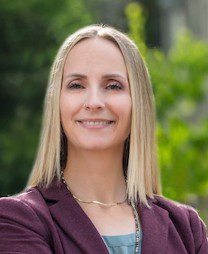
When Mandy Kroetsch met Matthew Parker last year in the Berkeley Haas MBA for Executives Program, she was juggling classes while bidding on houses in southern California.
“I was getting up at 4 a.m. and checking listings,” said Kroetsch, EMBA 23. “I found houses that came on the market before my agent even told me.”
Kroetsch started questioning the value of her real estate agent. Meanwhile, her challenges confirmed for Parker, a veteran Seattle real estate broker, that she probably didn’t need one.
So Parker decided to solve the problem by partnering with EMBA classmates to create startup Alokee. The company, which functions as a virtual real estate agent, empowers California home buyers to bid directly on properties.
The site is designed for people who grew up banking, paying bills, and shopping for most everything online without an intermediary, Parker said.
“Increasingly, Gen Z and other digital natives are baffled by why they have to talk to a real estate broker when they find all of the listings and tour the properties themselves and want to just make an offer,” Parker said.
“Increasingly, Gen Z and other digital natives are baffled by why they have to talk to a real estate broker.” —Matt Parker
Ease of use, money back
Launched nine months ago, the Alokee website is live in California, featuring photos of homes that have sold in San Jose and San Diego. The company plans to expand soon, and has a waiting list to beta test the site with customers in Washington, Oregon, Arizona, and Nevada.
Alokee’s selling point is its ease of use: Create an account, provide proof of funds for a down payment, and then “make 12-to-15 decisions” on offer price, a closing date, loan payment schedule and amount, and other sales decisions. A buyer could potentially be in contract to buy a house in a matter of minutes, Parker said.
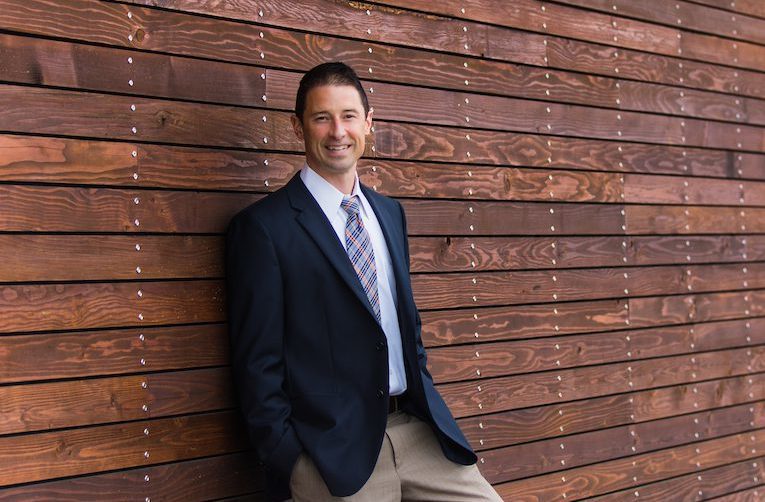
A second benefit is that the buyer receives a chunk of the agent’s fee in cash back after a sale. In San Francisco, for example, where the agent commission on a home sale averages $40,000, Alokee takes a set fee of $9,000 and returns $31,000 to the buyer. “We don’t want to chase down the big commissions,” Parker said. He added that the check comes at a perfect time, as buyers typically invest the most in their houses—additions like solar panels, window replacements, energy-efficient appliances, and insulation—at the time of purchase.
An EMBA team
Parker started Alokee with classmate Hamed Adibnatanzi, a legal affairs veteran. Adibnatanzi used his law expertise to make sure that the mass of paperwork required for any real estate deal on the site was simplified for a direct buyer and met federal, state, and local requirements.
Meanwhile, the team is still sorting out the website’s technical complexities. Noman Shaukat manages the code behind the offers that flow through the site. “It’s a technical challenge, not a legal one for us,” Parker said.
Parker also asked Marcus Rossi, a former commanding officer with the U.S. Marines, to be Alokee’s COO and invited Kroetsch, a chemical engineer by trade, to join as CMO. “I told him I’d love to help,” said Kroetsch, who worked with a branding agency to come up with the name Alokee, which combines the words Aloha and key (meaning the key to a house).
“We are working through the marketing plan right now, and I am happy to be a part of this team,” she said.
Learning to scale
This is Parker’s second startup. He came to Haas after starting national home improvement repair and renovation service ZingFix. At ZingFix, he realized that there are different skills required to manage a company as it scales across state lines. “A quickly-growing startup was a new business challenge for me,” he said. “The more people that joined, the more I realized that I would need an MBA to take care of our stakeholders.”
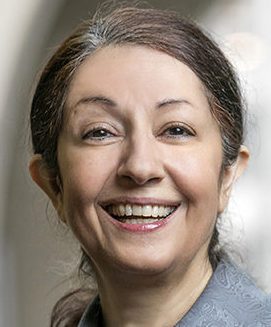
Deciding on Haas, he said the program has provided priceless support for what he’s trying to achieve, from mentorship to participating in the UC LAUNCH accelerator program and competition, in which Alokee was a finalist. “Once you get to the finals of LAUNCH you get introduced to top-tier mentors and a storytelling coach. These people understand what you are doing, and they pick apart your business model,” he said. Senior Lecturer Homa Bahrami spent time coaching the team, helping them to develop a hiring framework. “Everything she told us was correct,” Parker said. “She’s probably in the top 10 smartest people I’ve met in my life.”
He added that Distinguished Teaching Fellow Maura O’Neill’s New Venture Finance course also helped them navigate as the company works to land a seed round of funding.
While saving homebuyers money is a goal, Parker said the company will build more gender and racial equity into the home buying process by giving buyers direct bidding power. “Homes are how people stay in power and get in power,” he said. “We want to give all people the power to win in the real estate game.”
Students discuss why a part-time MBA program suited them (and might suit you too)
Seeking an MBA to change the future of health care
Three teams honored for innovation at Cleantech to Market Summit
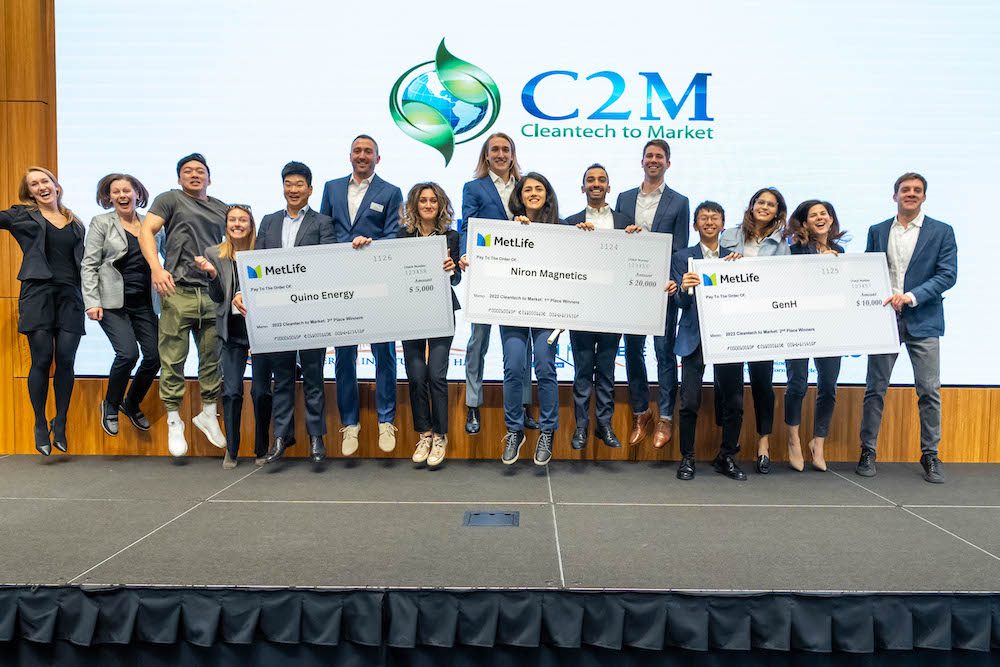
Three teams that included Berkeley Haas MBA students won top awards at the annual Cleantech to Market (C2M) Climate Tech Summit last Friday.
C2M is a partnership between graduate students, startups, and industry professionals to help accelerate commercialization of cleantech solutions. Over 15 weeks, each C2M team spends nearly 1,000 hours assessing leading-edge technologies and investigating market opportunities.
Last week, teams presented their findings, followed by an audience Q&A. Dean Ann Harrison also took the stage, interviewed by Financial Times correspondent Dave Lee about the school’s work to put sustainability at the core of business education.
This year’s winners of the MetLife Climate Solutions Awards included:
Niron Magnetics: The team won $20,000 for working on powerful, low cost, and environmentally-sustainable permanent magnets to free electrification from dependence on rare earth elements. The team included Andrew Cahill, EWMBA 23, Ben Brokesh, JD 24, Campbell Scott, MBA 23, Yiannos Vakis, MBA 23, and Sepideh Karimiziarani, MS 22, Development Engineering.
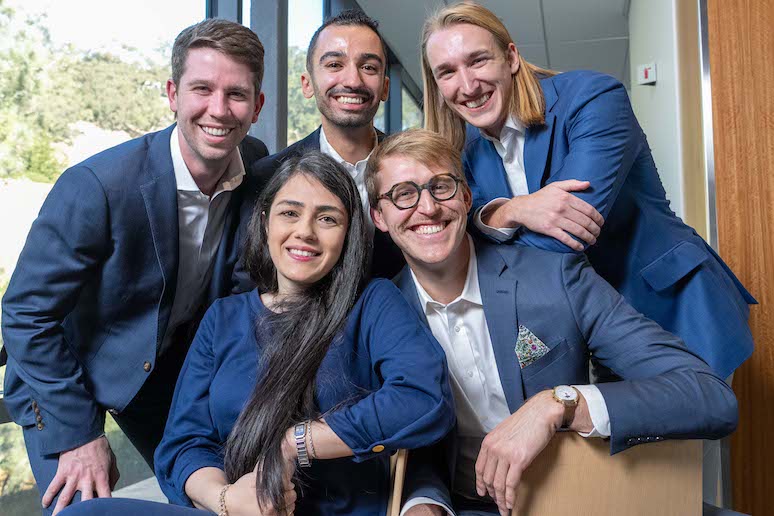
GenH: The team won $10,000 for working on a rapidly deployable, fully modular hydropower system to electrify non-powered dams and canal heads to generate clean, stable, and cost-competitive renewable energy. Team members included Emily Robinson, EWMBA 23, Hon Leung “Curtis” Wong, MS 23, Development Engineering, Maelym Medina, MBA 23, and Santiago Recabarren, MBA 23.
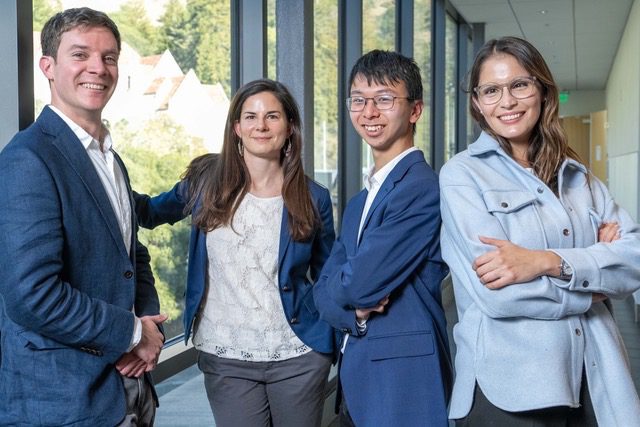
Quino Energy: The team won $5,000 for working on scalable, non-flammable energy storage made possible by a proprietary zero-waste process that transforms coal and wood tar into designer flow-battery reactants. Team members included Dongwan Kim, MBA 23, Ingrid Xhafa, MS 23, Development Engineering, James Wang, MBA 23, Kennedy McCone, graduate student researcher, UC Berkeley College of Chemistry, and Noah Carson, EMBA 23.
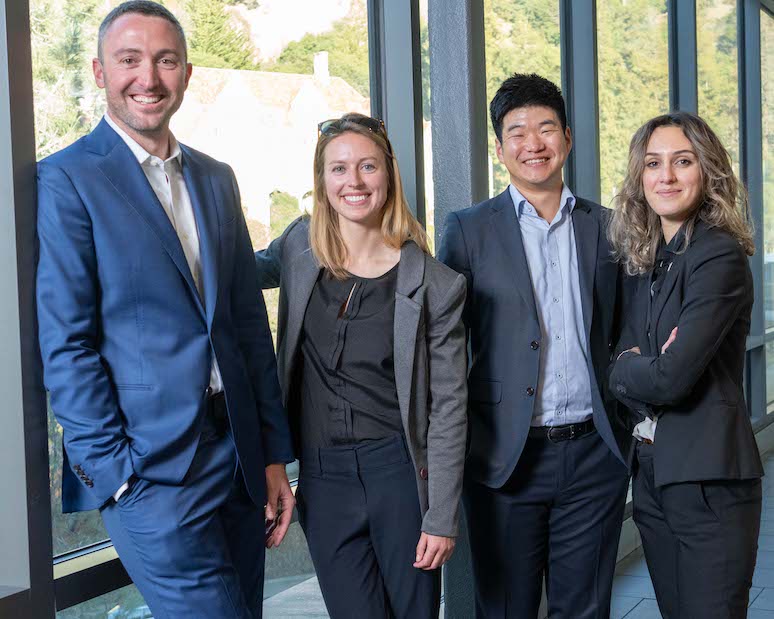
The Quino Energy team also won the Hasler Cleantech to Market Award as audience favorite based on online polling throughout the day.
MetLife is a corporate sponsor of the C2M Program; The Financial Times served as an event partner.